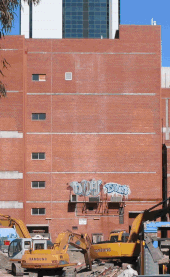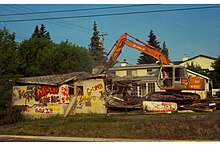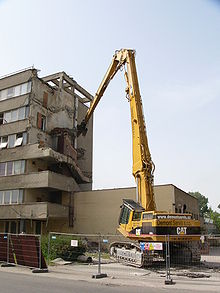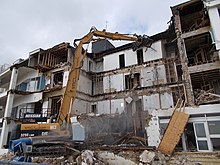
Implosion is a process in which objects are destroyed by collapsing on themselves. The opposite of explosion, implosion reduces the volume occupied and concentrates matter and energy. True implosion usually involves a difference between internal (lower) and external (higher) pressure, or inward and outward forces, that is so large that the structure collapses inward into itself, or into the space it occupied if it is not a completely solid object. Examples of implosion include a submarine being crushed from the outside by the hydrostatic pressure of the surrounding water and the collapse of a massive star under its own gravitational pressure.

Heavy equipment, heavy machinery, earthmovers, construction vehicles, or construction equipment, refers to heavy-duty vehicles specially designed to execute construction tasks, most frequently involving earthwork operations or other large construction tasks. Heavy equipment usually comprises five equipment systems: the implement, traction, structure, power train, and control/information.
Prefabrication is the practice of assembling components of a structure in a factory or other manufacturing site, and transporting complete assemblies or sub-assemblies to the construction site where the structure is to be located. Some researchers refer it to “various materials joined together to form a component of the final installation procedure“.
This page is a list of construction topics.

A wrecking ball is a heavy steel ball, usually hung from a crane, that is used for demolishing large buildings. It was most commonly in use during the 1950s and 1960s. Several wrecking companies claim to have invented the wrecking ball. An early documented use was in the breaking up of the SS Great Eastern in 1888–1889, by Henry Bath and Co, at Rock Ferry on the River Mersey.

In the context of physical construction, deconstruction is the selective dismantlement of building components, specifically for reuse, repurposing, recycling, and waste management. It differs from demolition where a site is cleared of its building by the most expedient means. Deconstruction has also been defined as "construction in reverse". Deconstruction requires a substantially higher degree of hands-on labor than does traditional demolition, but as such provides a viable platform for unskilled or unemployed workers to receive job skills training. The process of dismantling structures is an ancient activity that has been revived by the growing fields of sustainable and green building.

Concrete recycling is the use of rubble from demolished concrete structures. Recycling is cheaper and more ecological than trucking rubble to a landfill. Crushed rubble can be used for road gravel, revetments, retaining walls, landscaping gravel, or raw material for new concrete. Large pieces can be used as bricks or slabs, or incorporated with new concrete into structures, a material called urbanite.

The New Safe Confinement is a structure put in place in 2016 to confine the remains of the number 4 reactor unit at the Chernobyl Nuclear Power Plant, in Ukraine, which was destroyed during the Chernobyl disaster in 1986. The structure also encloses the temporary Shelter Structure (sarcophagus) that was built around the reactor immediately after the disaster. The New Safe Confinement is designed to prevent the release of radioactive contaminants, protect the reactor from external influence, facilitate the disassembly and decommissioning of the reactor, and prevent water intrusion.
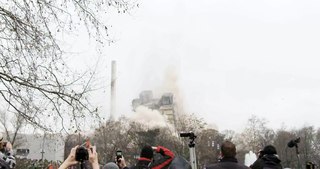
In the controlled demolition industry, building implosion is the strategic placing of explosive material and timing of its detonation so that a structure collapses on itself in a matter of seconds, minimizing the physical damage to its immediate surroundings. Despite its terminology, building implosion also includes the controlled demolition of other structures, like bridges, smokestacks, towers, and tunnels.

Construction waste or debris is any kind of debris from the construction process. Different government agencies have clear definitions. For example, the United States Environmental Protection Agency EPA defines construction and demolition materials as “debris generated during the construction, renovation and demolition of buildings, roads, and bridges.” Additionally, the EPA has categorized Construction and Demolition (C&D) waste into three categories: non-dangerous, hazardous, and semi-hazardous.

Construction aggregate, or simply aggregate, is a broad category of coarse- to medium-grained particulate material used in construction, including sand, gravel, crushed stone, slag, recycled concrete and geosynthetic aggregates. Aggregates are the most mined materials in the world. Aggregates are a component of composite materials such as concrete and asphalt; the aggregate serves as reinforcement to add strength to the overall composite material. Due to the relatively high hydraulic conductivity value as compared to most soils, aggregates are widely used in drainage applications such as foundation and French drains, septic drain fields, retaining wall drains, and roadside edge drains. Aggregates are also used as base material under foundations, roads, and railroads. In other words, aggregates are used as a stable foundation or road/rail base with predictable, uniform properties, or as a low-cost extender that binds with more expensive cement or asphalt to form concrete. Although most kinds of aggregate require a form of binding agent, there are types of self-binding aggregate which require no form of binding agent.

Hydrodemolition is a concrete removal technique which utilizes high-pressure water, often containing an abrasive material, to remove deteriorated and sound concrete as well as asphalt and grout. This process provides an excellent bonding surface for repair material and new coating applications. First developed in Europe in the 1980s, this technology has become widely accepted for concrete removal and surface preparation throughout Europe and North America.

A deep foundation is a type of foundation that transfers building loads to the earth farther down from the surface than a shallow foundation does to a subsurface layer or a range of depths. A pile or piling is a vertical structural element of a deep foundation, driven or drilled deep into the ground at the building site.

The following outline is provided as an overview of and topical guide to construction:
A bucket is a specialized container attached to a machine, as compared to a bucket adapted for manual use by a human being. It is a bulk material handling component.
Controlled Demolition, Inc. (CDI) is a controlled demolition firm headquartered in Phoenix, Maryland. The firm was founded by Jack Loizeaux who used dynamite to remove tree stumps in the Baltimore, Maryland area, and moved on to using explosives to take down chimneys, overpasses and small buildings in the 1940s. The company has demolished several notable buildings by implosion, including the Gettysburg National Tower, the Seattle Kingdome, and the uncollapsed portion of the Champlain Towers South condominium.

Demolition waste is waste debris from destruction of buildings, roads, bridges, or other structures. Debris varies in composition, but the major components, by weight, in the US include concrete, wood products, asphalt shingles, brick and clay tile, steel, and drywall. There is the potential to recycle many elements of demolition waste.
1031 Canal was a partially collapsed 190-foot-tall (58 m) multi-use high-rise building in New Orleans, Louisiana, located at 1031 Canal Street in the Central Business District. If completed, the project would have been known as the Hard Rock Hotel New Orleans.

The implosion of Radio Network House in 2012 was the first implosion used in New Zealand to demolish a building, and was a "test case" for the potential to use such a demolition method on similar buildings in Christchurch Central City that had been damaged in the 2011 earthquake. Like most other large buildings in central Christchurch, Radio Network House was damaged beyond repair in the 2011 earthquake, and the Canterbury Earthquake Recovery Authority (CERA) added it to the demolition list in August 2011. In July 2012, it was announced that the building was going to be imploded, involving a specialist company from the United States with considerable experience in this type of work.
